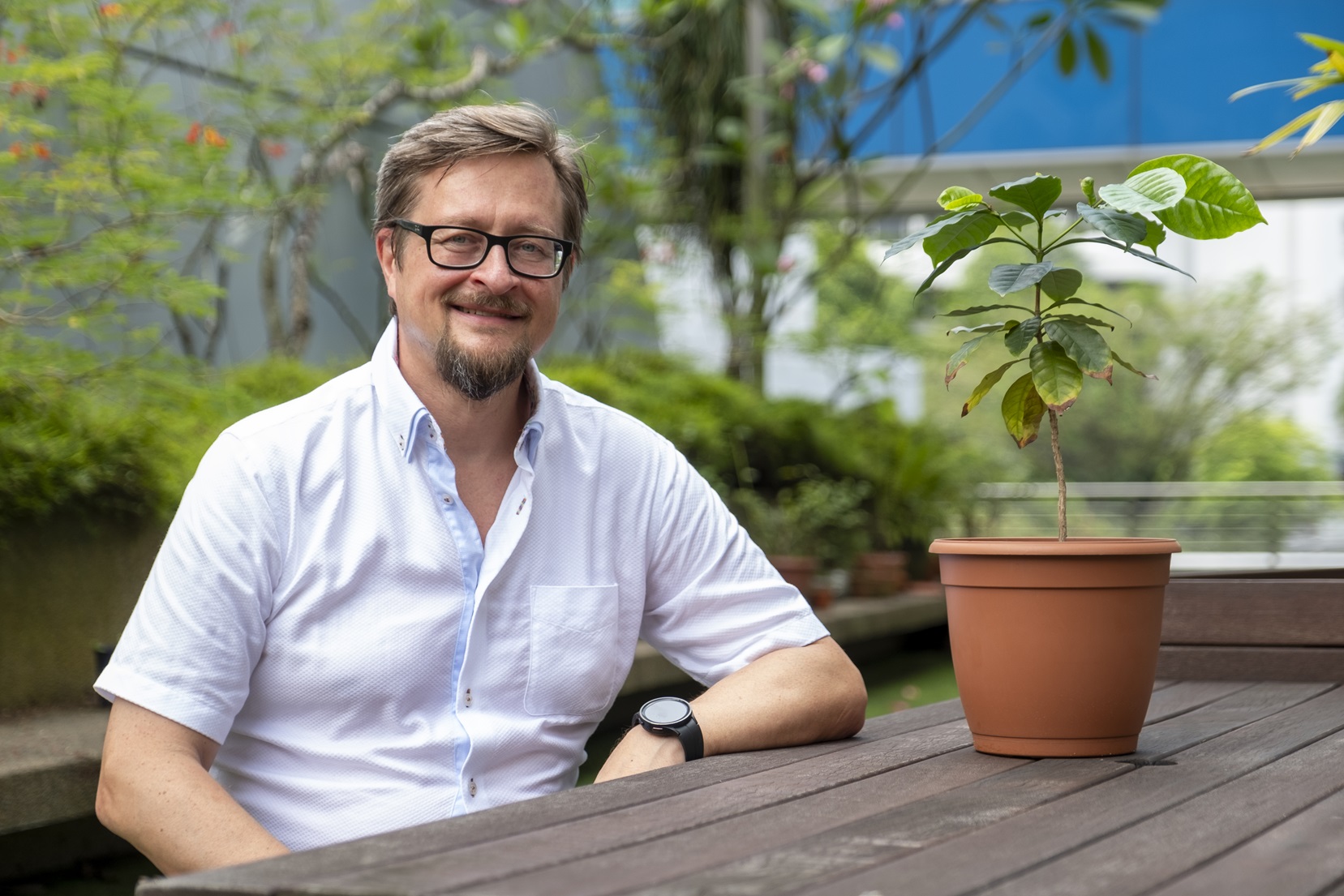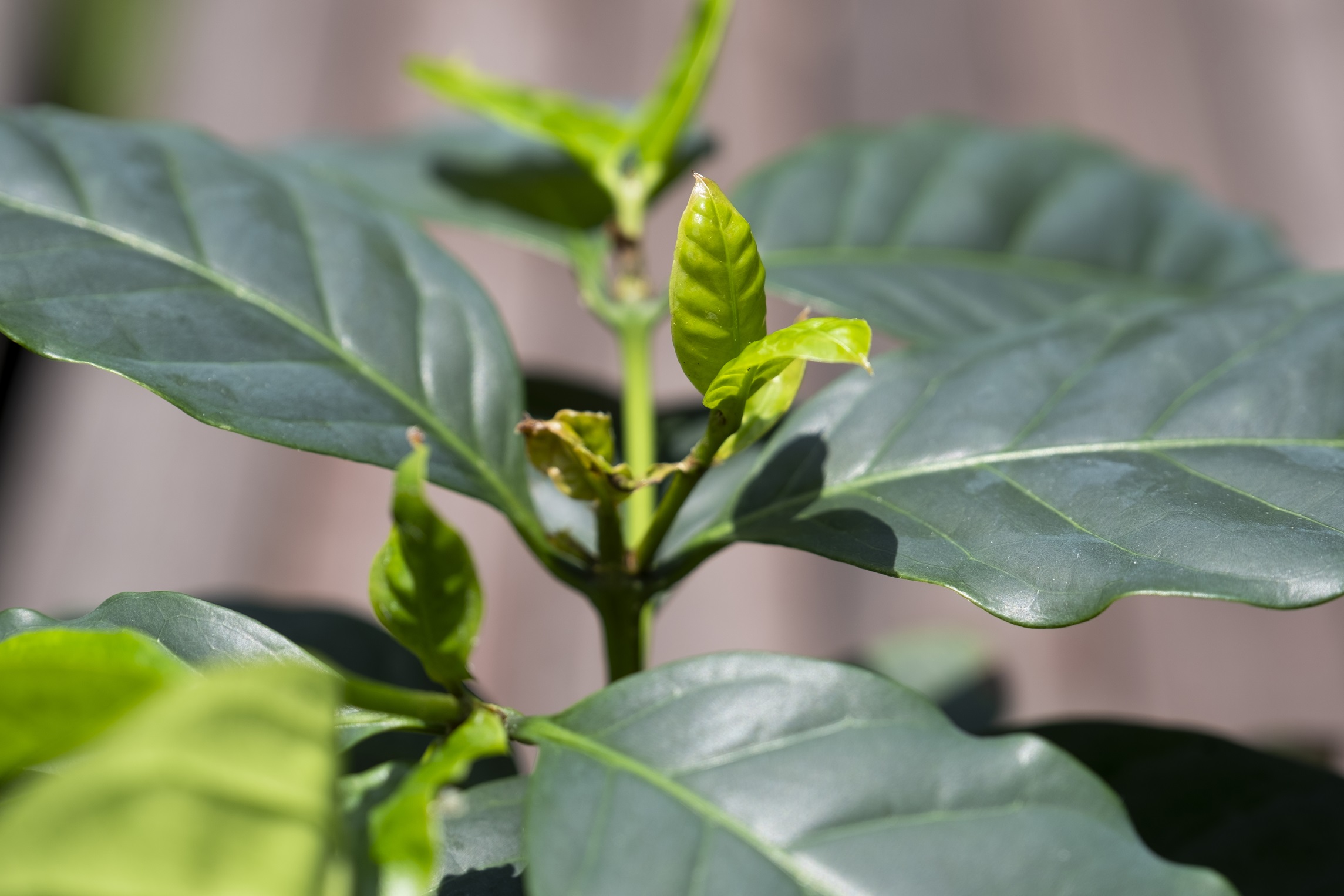Scientists find common genes defending coffee plants against devastating disease
Genomes of coffee plants mapped to identify other useful traits.

Assistant Professor Jarkko Salojarvi, from NTU Singapore’s School of Biological Sciences, co-led an international research team that mapped out the genomes of the Arabica plant (pictured) and two related coffee plants. (Credit: NTU Singapore)
Arabica coffee is the most economically important coffee globally and accounts for 60 per cent of coffee products worldwide. But the plants it hails from are vulnerable to a disease that, in the 1800s, devastated Sri Lanka’s coffee empire.
Now, an international team of researchers co-led by Nanyang Technological University, Singapore (NTU Singapore) has made a breakthrough that helps protect Arabica plants (Coffea arabica) against the fungal disease, called coffee leaf rust.
The other co-leads of the study, published in Nature Genetics, are based at the world's largest food and beverage company Nestlé, the Université de Montpellier in France and the University at Buffalo in the United States.
The scientists mapped out, in great detail, all the genetic material – or genomes – of Arabica and two related coffee plants. This allowed the team to identify a new combination of genes shared by the plants that are resistant to coffee leaf rust. With the data on the genomes, other useful traits in coffee plants can also be identified.
Discovering the resistance genes opens the way to better protect coffee lovers’ daily fix and maintain their drink’s high-quality taste, thereby supporting an industry employing millions of workers. According to the International Coffee Organisation, the livelihoods of 125 million people around the world depend on the coffee business.
Coffee leaf rust disease has wreaked havoc on coffee-producing nations and continues to wipe out coffee farms today. The United States Agency for International Development estimated that between 2012 and 2014, an outbreak of coffee leaf rust caused about US$1 billion (S$1.36 billion) in economic damages in Latin America.
Assistant Professor Jarkko Salojarvi from NTU’s School of Biological Sciences, who co-led the research team, said: “The high-quality genome sequences of the three plant species, together with the candidate genetic sequences for coffee leaf rust resistance, form the cornerstone for breeding new varieties of Arabica plants that are more adaptable to change and more resistant to diseases caused by pathogens like fungi.”
The project involved a large consortium of researchers and coffee breeders from Australia, Belgium, Brazil, Canada, China, Colombia, Finland, France, Germany, Indonesia, Italy, the Netherlands, South Africa, Spain, Switzerland, Uganda and the United States.
Dr Patrick Descombes, Senior Expert in Genomics at Nestlé Research, and one of the study’s co-leads, said: “While other public references for Arabica do exist, the quality of our team’s work is extremely high. We used state-of-the-art genomics approaches – including long and short reads high throughput sequencing – to create the most advanced, complete and continuous Arabica reference to date.”
Poor genetic variability

The Arabica coffee plant. (Credit: NTU Singapore)
Arabica plants have low genetic diversity, which makes them susceptible to pests and diseases. The cultivated plants typically do not have the genetic trait that confers resistance to coffee leaf rust, which is caused by the Hemileia vastatrix fungi.
The fungi form orange-yellow spots on the coffee plants’ leaves, which eventually wither and fall. The loss of leaves lowers the quality and quantity of the plants’ berries harvested for brewing coffee.
To prevent a potentially disastrous wipeout of Arabica plants worldwide by coffee leaf rust, the scientists studied the genomic origins and breeding history of the plant.
They did so by mapping out the highly detailed genomic sequences of Arabica and two related coffee-producing plants, Robusta (C. canephora) and C. eugenioides, which are the modern-day ancestors of Arabica.
This was done using advanced techniques, namely PacBio high fidelity technology to sequence DNA with high accuracy, and high throughput chromosome conformation capture to create detailed 3D maps of how different DNA segments interact. The data for the genomes are publicly available (see notes below).
The scientists’ analysis suggested that the resistance to coffee leaf rust in Arabica may have been lost when Arabica plants became widely cultivated, as all cultivated Arabica coffee plants are derived from the same stock with very little genetic variability.
However, a hybrid of Arabica and Robusta resistant to the disease was found on Timor island in 1927. Unfortunately, the resistance comes with a trade-off as the hybrid does not produce coffee that tastes as good as that from other Arabica plants.
With no alternatives, the descendants of the Timor hybrid plant still form the basis of all coffee leaf rust resistant variants.
Previous research discovered some genes that potentially conferred resistance against leaf rust in different coffee plants. But without a map of the various coffee plants’ genome, it was difficult to accurately identify these genes and hard to figure out if they were also found in other coffee plants, which would increase the chance that they coded for resistance. The gene identification process was also slow.
However, with the new research mapping out the genomes of different coffee plants in great detail, identifying resistance genes will be faster and more accurate.
Using the plants’ genome information, the researchers analysed the most common cultivated coffee varieties, representing about 95 per cent of the world’s coffee production, and compared them with descendants of the Timor hybrid.
This allowed them to find a region of DNA sequences common among different leaf rust resistant coffee plants, with a new combination of Robusta-based genes that may convey resistance in Arabica plants in general. Knowing the existence of these shared genes greatly increases the likelihood that these genetic sequences can indeed defend against leaf rust, and could allow breeders to select for them when growing new coffee varieties.
Through their analysis, the researchers also postulated that Arabica stemmed from a chance event 350,000 to 610,000 years ago when the Robusta and C. eugenioides plants were naturally cross-pollinated to create the first Arabica plants in the wild.
This dating comes in between previous estimates, with an earlier one putting the chance event to as recently as 20,000 years ago, while others push it as far back as one million years ago. The researchers said the discrepancy of earlier figures could be due to historical changes in population sizes in the wild and cultivated plants, as well as the different sources and limited amount of data used.
By comparing the high-quality genomic sequences of Arabica with those of Robusta and C. eugenioides, the research team found that the three species are still highly similar genetically. This suggests that for future breeding programmes to ensure that Arabica plants have disease resistance, breeders can consider using other related coffee species, such as Robusta and C. eugenioides.
Using Arabica plants alone to breed for the resistance trait is problematic because the study found that even the wild varieties of Arabica, not just the cultivated ones, have very low genetic diversity, making it harder to breed for disease resistance.
“The low genetic diversity of both cultivated and wild modern Arabica plants is an obstacle for its breeding using the wild varieties of the plants. But close similarities found between Arabica, Robusta and C. eugenioides plants are likely to facilitate the introduction of interesting traits from the latter two into Arabica,” said Asst Prof Salojarvi.
The highly detailed genomic sequences mapped for all three coffee plants also mean that other useful traits could be identified in future, such as resilience to drought, better crop yield and more aromatic coffee beans.
These traits can be identified with genetic markers, which can be used to predict the future performance of coffee seedlings, instead of waiting years for the plants to mature and bear berries to find out.
Since the leaf rust resistant hybrid from Timor does not produce coffee that is as good as that from the usual Arabica plants, the genome data compiled now provides a fast track for researchers to breed new disease-resistant plants that still retain the sublime, smooth and sweet taste of Arabica enjoyed by coffee lovers worldwide.
Notes:
Paper titled “The genome and population genomics of allopolyploid Coffea arabica reveal the diversification history of modern coffee cultivars”, published in Nature Genetics, 15 April 2024. DOI: 10.1038/s41588-024-01695-w
The high-quality genomes of Arabica, Robusta and C. eugenioides can be found here.


.tmb-listing.jpg?Culture=en&sfvrsn=82921582_1)

.tmb-listing.jpg?Culture=en&sfvrsn=370a7c71_1)

.tmb-listing.jpg?Culture=en&sfvrsn=ab6472c8_1)
